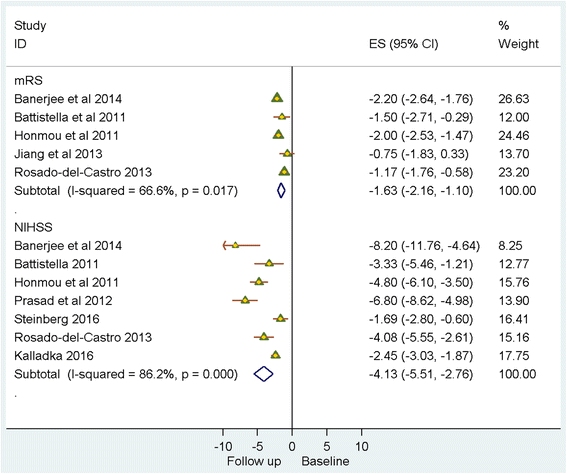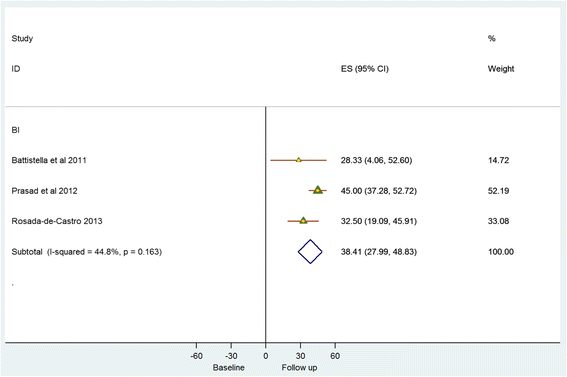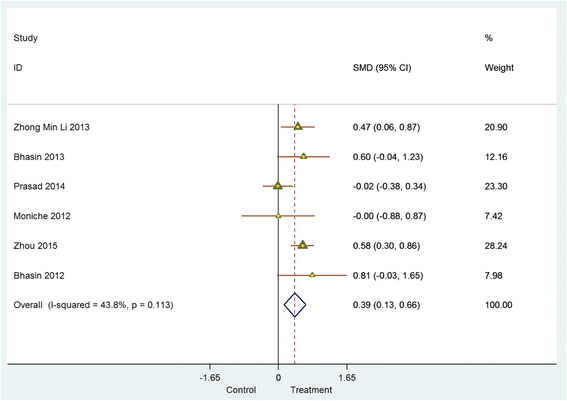Safety and effectiveness of stem cell therapies in early-phase clinical trials in stroke: a systematic review and meta-analysis
- PMID: 28854961
- PMCID: PMC5577822
- DOI: 10.1186/s13287-017-0643-x
Safety and effectiveness of stem cell therapies in early-phase clinical trials in stroke: a systematic review and meta-analysis
Abstract
Stem cells have demonstrated encouraging potential as reparative therapy for patients suffering from post-stroke disability. Reperfusion interventions in the acute phase of stroke have shown significant benefit but are limited by a narrow window of opportunity in which they are beneficial. Thereafter, rehabilitation is the only intervention available. The current review summarises the current evidence for use of stem cell therapies in stroke from early-phase clinical trials. The safety and feasibility of administering different types of stem cell therapies in stroke seem to be reasonably proven. However, the effectiveness needs still to be established through bigger clinical trials with more pragmatic clinical trial designs that address the challenges raised by the heterogeneous nature of stroke per se, as well those due to unique characteristics of stem cells as therapeutic agents.
Keywords: Clinical design; Outcomes; Regenerative medicine; Stem cells; Stroke.
Conflict of interest statement
Ethics approval and consent to participate
Not applicable.
Consent for publication
Not applicable.
Competing interests
The authors declare that they have no competing interests.
Publisher’s Note
Springer Nature remains neutral with regard to jurisdictional claims in published maps and institutional affiliations.
Figures






References
-
- Feigin VLFM, Krishnamurthi R, Mensah GA, Connor M, Bennett DA, Moran AE, Sacco RL, Anderson L, Truelsen T, O’Donnell M, Venketasubramanian N, Barker-Collo S, Lawes CM, Wang W, Shinohara Y, Witt E, Ezzati M, Naghavi M, Murray C. Global and regional burden of stroke during 1990-2010: findings from the Global Burden of Disease Study 2010. Lancet. 2014;383(9913):245–254. doi: 10.1016/S0140-6736(13)61953-4. - DOI - PMC - PubMed
-
- Sacco RL, Kasner SE, Broderick JP, Caplan LR, Connors JJ, Culebras A, et al. An updated definition of stroke for the 21st century: a statement for healthcare professionals from the American Heart Association/American Stroke Association. Stroke. 2013;44(7):2064–2089. doi: 10.1161/STR.0b013e318296aeca. - DOI - PMC - PubMed
-
- Kim JT, Fonarow GC, Smith EE, Reeves MJ, Navalkele DD, Grotta JC, et al. Treatment with TPA in the “golden hour” and the shape of the 4.5 hour time-benefit curve in the national US Get With The Guidelines-Stroke population. Circulation. 2017;135:128–39. doi:10.1161/CIRCULATIONAHA.116.023336. - PubMed
Publication types
MeSH terms
LinkOut - more resources
Full Text Sources
Other Literature Sources
Medical

